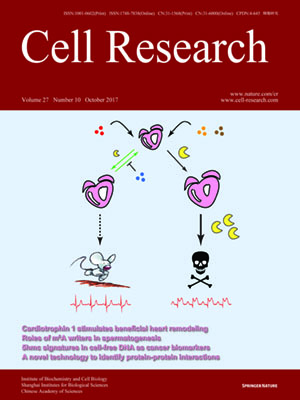
Volume 27, No 10, Oct 2017
ISSN: 1001-0602
EISSN: 1748-7838 2018
impact factor 17.848*
(Clarivate Analytics, 2019)
Volume 27 Issue 10, October 2017: 1289-1292 | Open Access
LETTERS TO THE EDITOR
Enhanced base editing by co-expression of free uracil DNA glycosylase inhibitor
Lijie Wang1,2,3,*, Wei Xue4,*, Lei Yan1,2,3,5,*, Xiaosa Li1,2,3, Jia Wei4, Miaomiao Chen1, Jing Wu1, Bei Yang5, Li Yang4 and Jia Chen1
1School of Life Science and Technology, ShanghaiTech University, Shanghai 201210, China
2Shanghai Institute of Biochemistry and Cell Biology, Chinese Academy of Sciences, Shanghai 200031, China
3University of Chinese Academy of Sciences, Beijing 100049, China
4Key Laboratory of Computational Biology, CAS-MPG Partner Institute for Computational Biology, Shanghai Institutes for Biological Sciences, Chinese Academy of Sciences, Shanghai 200031, China
5Shanghai Institute for Advanced Immunochemical Studies, ShanghaiTech University, Shanghai 201210, China
Correspondence: Bei Yang, E-mail: yangbei@shanghaitech.edu.cn; Li Yang, E-mail: liyang@picb.ac.cn; Jia Chen,(chenjia@shanghaitech.edu.cn)
Base editors (BEs) have been recently developed by combining the APOBEC (apolipoprotein B mRNA editing enzyme, catalytic polypeptide-like)/AID (activation-induced deaminase) cytidine deaminase family members1 with the CRISPR/Cas9 system to perform targeted C-to-T base editing2, 3, 4, 5,6,7,8. Mechanistically, Cas9 variant-fused APOBEC/AID is directed to target site by sgRNA, introducing C-to-T substitution at the single-base level2,3,4. Compared to earlier generations of BEs (BE1 and BE2), the latest BE3 achieved much higher base editing frequencies by substituting catalytically-dead Cas9 (dCas9) with Cas9 nickase (nCas9)2.
10.1038/cr.2017.111
FULL TEXT | PDF
Browse 1712


